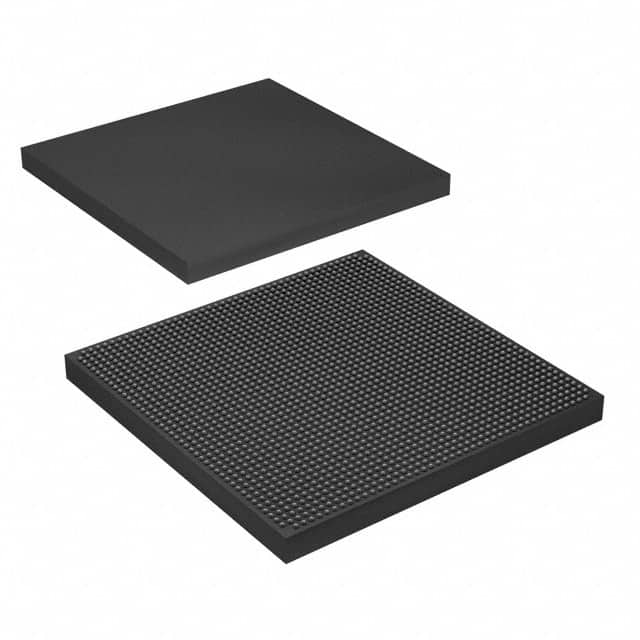Viz Specifikace pro podrobnosti o produktu.

5SGXEA7N2F45I2
Product Overview
Category
The 5SGXEA7N2F45I2 belongs to the category of Field Programmable Gate Arrays (FPGAs).
Use
FPGAs are integrated circuits that can be programmed and reprogrammed to perform various digital functions. The 5SGXEA7N2F45I2 is specifically designed for high-performance applications.
Characteristics
- High-performance FPGA with advanced features
- Large capacity and high-speed processing capabilities
- Flexible and reconfigurable design
- Low power consumption
- Robust and reliable performance
Package
The 5SGXEA7N2F45I2 comes in a compact package, suitable for integration into electronic systems.
Essence
The essence of the 5SGXEA7N2F45I2 lies in its ability to provide a customizable and high-performance solution for complex digital processing tasks.
Packaging/Quantity
The 5SGXEA7N2F45I2 is typically packaged individually and is available in various quantities depending on the customer's requirements.
Specifications
- Logic Elements: 220,000
- Embedded Memory: 8,400 Kbits
- DSP Blocks: 1,288
- Maximum User I/Os: 622
- Transceivers: 48
- Operating Voltage: 1.0V - 1.2V
- Operating Temperature: -40°C to 100°C
- Package Type: FCBGA
- Package Size: 45mm x 45mm
Detailed Pin Configuration
The 5SGXEA7N2F45I2 has a comprehensive pin configuration, including input/output pins, power supply pins, and configuration pins. For detailed pin configuration information, please refer to the product datasheet.
Functional Features
- High-speed data processing capabilities
- Support for various communication protocols
- On-chip memory for efficient data storage and retrieval
- Flexible I/O interfaces for seamless integration with external devices
- Built-in DSP blocks for signal processing tasks
- Configurable logic elements for custom digital circuit implementation
Advantages and Disadvantages
Advantages
- High-performance and customizable solution
- Reconfigurable design allows for flexibility in system development
- Large capacity and high-speed processing capabilities
- Low power consumption compared to alternative solutions
- Robust and reliable performance
Disadvantages
- Higher cost compared to traditional microcontrollers or ASICs
- Steeper learning curve for programming and utilizing FPGA capabilities
- Limited availability of skilled professionals for FPGA development and maintenance
Working Principles
The 5SGXEA7N2F45I2 operates based on the principles of reconfigurable logic. It consists of a matrix of configurable logic elements interconnected through programmable routing resources. The user can program the FPGA to implement desired digital functions by configuring the interconnections and functionality of the logic elements.
Detailed Application Field Plans
The 5SGXEA7N2F45I2 finds applications in various fields, including:
- Telecommunications: Used in base stations, routers, and network switches for high-speed data processing and protocol handling.
- Aerospace and Defense: Employed in radar systems, avionics, and military communication equipment for real-time signal processing and data encryption.
- Industrial Automation: Utilized in control systems, robotics, and machine vision applications for high-performance data processing and sensor interfacing.
- Medical Devices: Integrated into medical imaging systems, patient monitoring devices, and laboratory equipment for advanced signal processing and data analysis.
- Automotive: Applied in advanced driver assistance systems (ADAS), infotainment systems, and engine control units (ECUs) for real-time data processing and control.
Detailed and Complete Alternative Models
- 5SGXEA7N2F45C2
- 5SGXEA7N2F45I3
- 5SGXEA7N2F45C3
- 5SGXEA7N2F45I4
These alternative models offer similar features and capabilities to the 5SGXEA7N2F45I2, with slight variations in specifications and performance characteristics.
Note: The above information is subject to change. For the most accurate and up-to-date details, please refer to the product datasheet provided by the manufacturer.
Word Count: 570
Seznam 10 běžných otázek a odpovědí souvisejících s aplikací 5SGXEA7N2F45I2 v technických řešeních
Sure! Here are 10 common questions and answers related to the application of 5SGXEA7N2F45I2 in technical solutions:
1. What is the 5SGXEA7N2F45I2 FPGA used for? The 5SGXEA7N2F45I2 is a Field-Programmable Gate Array (FPGA) that can be used for various applications such as high-performance computing, networking, telecommunications, and industrial automation.
2. What are the key features of the 5SGXEA7N2F45I2 FPGA? Some key features of this FPGA include a high logic density, high-speed transceivers, embedded memory blocks, DSP capabilities, and support for various communication protocols.
3. How can the 5SGXEA7N2F45I2 FPGA be programmed? The 5SGXEA7N2F45I2 FPGA can be programmed using hardware description languages (HDLs) such as VHDL or Verilog, or through graphical programming tools like Quartus Prime.
4. Can the 5SGXEA7N2F45I2 FPGA be used for real-time signal processing? Yes, the 5SGXEA7N2F45I2 FPGA is capable of real-time signal processing due to its high-speed transceivers and embedded digital signal processing (DSP) blocks.
5. What kind of interfaces does the 5SGXEA7N2F45I2 FPGA support? This FPGA supports various interfaces including PCIe, Ethernet, USB, DDR3/DDR4 memory, HDMI, and many more, making it versatile for different applications.
6. Is the 5SGXEA7N2F45I2 FPGA suitable for high-bandwidth data processing? Yes, the 5SGXEA7N2F45I2 FPGA is well-suited for high-bandwidth data processing due to its high-speed transceivers and large embedded memory blocks.
7. Can the 5SGXEA7N2F45I2 FPGA be used in safety-critical applications? Yes, the 5SGXEA7N2F45I2 FPGA can be used in safety-critical applications as it supports various fault-tolerant features and has built-in error detection and correction capabilities.
8. What kind of power requirements does the 5SGXEA7N2F45I2 FPGA have? The power requirements of the 5SGXEA7N2F45I2 FPGA depend on the specific configuration and usage, but typically it requires a supply voltage of around 1.0V to 1.2V.
9. Can the 5SGXEA7N2F45I2 FPGA be reprogrammed multiple times? Yes, the 5SGXEA7N2F45I2 FPGA is a reprogrammable device, allowing users to modify and reconfigure the design multiple times during development or in the field.
10. Are there any development kits available for the 5SGXEA7N2F45I2 FPGA? Yes, Intel (formerly Altera) provides development kits like the Arria V GX Starter Kit that include the 5SGXEA7N2F45I2 FPGA, allowing developers to quickly prototype and evaluate their designs.
Please note that the specific details and answers may vary depending on the context and application of the 5SGXEA7N2F45I2 FPGA.

